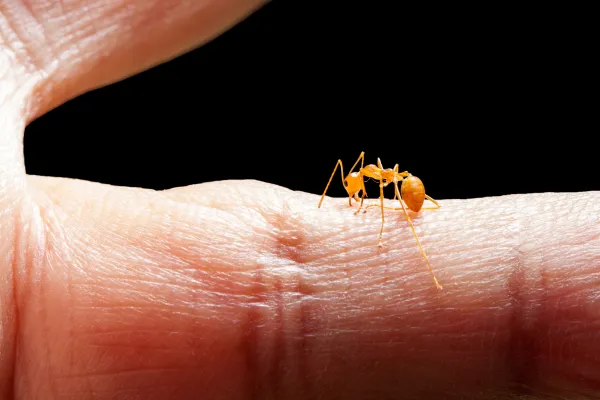
BLOGS
BLOG

From Pain to Prevention: How to Manage Red Fire Ant Bites
If you’ve ever stumbled into a colony of red fire ants, you likely remember the sharp, burning sensation that follows. These tiny invaders, often overlooked due to their size, can cause significant discomfort with their painful bites. But what exactly makes red fire ant bites so painful, and how can you manage and prevent them? Let’s delve into the world of these notorious pests and arm you with the knowledge to handle an encounter.
Understanding the Red Fire Ant
Red fire ants, scientifically known as Solenopsis invicta, are notorious for their aggressive behavior and painful stings. Native to South America, these ants have spread across the southeastern United States and beyond. They thrive in warm climates and are commonly found in disturbed areas, such as gardens, parks, and even your backyard.
What sets red fire ants apart from other ant species is their venom. When they bite, they inject a toxin called solenopsin. This venom activates pain receptors in the skin, leading to that distinctive burning sensation. The sting can feel like a sharp pinch followed by intense itching and swelling, which can last for hours or even days.
Understanding the Ecological Role of Fire Ants
While red fire ants are often seen as pests, it’s important to recognize their role in the ecosystem. They are natural predators of various insects and can help control pest populations in gardens and agricultural settings. Fire ants also aerate the soil as they tunnel, which can benefit plant growth. However, their aggressive behavior and painful bites can make them a nuisance for humans. Understanding this dual nature of fire ants allows us to appreciate their ecological contributions while also taking necessary precautions to prevent unwanted encounters.
Symptoms of a Fire Ant Bite
Recognizing the symptoms of a red fire ant bite is crucial for effective management. Here are the common signs you might experience:
Initial Pain: A sudden sharp pain at the site of the bite, often described as burning or stinging.
Swelling: The affected area may swell significantly, sometimes extending beyond the bite site.
Itching: Intense itching can follow the initial pain, making the bite site feel uncomfortable.
Blisters: In some cases, small blisters filled with pus may develop within a day or two after the bite.
Allergic Reactions: While most people will experience localized symptoms, some individuals may have severe allergic reactions, leading to difficulty breathing, swelling of the face or throat, or hives.
If you experience severe symptoms, it’s vital to seek medical attention immediately.
Immediate Steps for Managing Fire Ant Bites
If you find yourself on the receiving end of a red fire ant bite, here are immediate steps you can take to alleviate the pain:
Get Away: The first step is to remove yourself from the area to prevent additional bites. Fire ants are aggressive and will swarm if they feel threatened.
Clean the Bite: Wash the affected area with soap and water to prevent infection. This helps remove any debris or venom left on the skin.
Apply Ice: To reduce swelling and numb the pain, apply an ice pack or a cold compress to the bite area for 10-15 minutes. This can help minimize discomfort.
Take Pain Relievers: Over-the-counter pain relievers like ibuprofen or acetaminophen can help manage pain and reduce inflammation.
Use Topical Treatments: Anti-itch creams or hydrocortisone ointments can help alleviate itching and swelling. For blisters, keep them clean and covered to prevent infection.
Monitor for Allergic Reactions: Be aware of any signs of an allergic reaction, such as difficulty breathing or swelling of the face. If these occur, seek emergency medical help immediately.
Long-Term Management and Prevention
While immediate relief is essential, preventing future bites is equally important. Here are strategies to keep red fire ants at bay:
1. Identify and Avoid Ant Mounds
Red fire ants build distinctive mounds that are often irregular and can vary in size. If you see these mounds, steer clear. Educating yourself and your family about what these mounds look like can help you avoid contact.
2. Maintain Your Yard
Keep your yard tidy by regularly mowing the lawn, trimming bushes, and removing debris where fire ants can nest. This reduces the likelihood of attracting them to your property.
3. Seal Entry Points
Inspect your home for any cracks or gaps that could allow fire ants to enter. Sealing these entry points can help keep them out of your living space.
4. Use Baits and Insecticides
If you have a fire ant problem in your yard, consider using bait stations or insecticides specifically designed for fire ants. Baits are particularly effective as they attract the ants, which then carry the poison back to their colony, ultimately eliminating the source of the infestation. Always follow the product instructions carefully and keep children and pets away from treated areas.
5. Professional Pest Control
If you find yourself overwhelmed by a fire ant infestation, it may be time to call in the experts. Professional pest control services, like Valley Wide Pest Control, have the knowledge and tools to effectively manage and eliminate fire ant populations. They can assess your property and provide tailored solutions to prevent future infestations.
Conclusion
Red fire ant bites can be incredibly painful, but understanding how to manage and prevent them can make a significant difference. By knowing what to do immediately after a bite and taking proactive steps to keep these pests at bay, you can protect yourself and your family from discomfort.
Remember, if you suspect a fire ant infestation, don’t hesitate to contact Valley Wide Pest Control. With our expertise and commitment to quality service, we’ll help you reclaim your space from these unwanted invaders. Stay safe, stay informed, and say goodbye to fire ant bites for good!
© 2024 Valley Wide Pest Control. All rights reserved.

